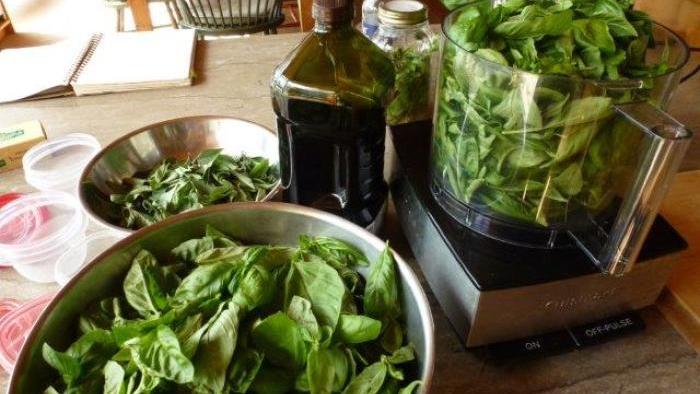Pesto is one of my top five favorite foods in all the world. I first ate it and learned to make it when I lived in Italy. It inspired me to write a book about basil, Basil, An Herb Lover’s Guide by Thomas DeBaggio and Susan Belsinger, Interweave Press, 1996. We grew 99 varieties; it was an awesome and aromatic summer. Here is the pesto recipe published in that book.
A simple pesto recipe
For centuries, Italians have made pesto with a mortar and pestle, hence the name pesto, which stems from the verb pestare, which means to pound or grind. Pesto prepared in this manner is by far the best, because it has a wonderful emulsion and is thick and creamy. The flavors are also more intense — the garlic is more pungent, the nuts are sweeter and more resinous, and the basil is rich in perfume. Nowadays, many of us use the food processor to make pesto since it is quick and easy. Directions for both methods are given below. Traditionally, pesto is served with a flat-type noodle such as trenette, fettuccine, or linguine.
Makes about 1 1/2 cups; enough to dress 1 pound of dry pasta or about 1 1/2 pounds fresh pasta
Ingredients:
5 cloves garlic, peeled and sliced
1/4 cup pine nuts
4 cups basil leaves
Salt
1/2 cup freshly grated Parmigiano cheese
About 3/4 cup extra-virgin olive oil
If you’re using a pestle and mortar, combine the garlic and pine nuts in a large mortar and crush them with the pestle into a smooth paste. Add the basil to the mortar, a handful at a time, crushing the leaves against the sides with the pestle. The mixture will be like a coarse, thick paste until the oil is added. Add a few pinches of salt to the basil.
Stir in the cheese. Drizzle the olive oil in slowly, a bit at a time, as you work it in. The pesto should become very smooth and there should not be any big pieces. Once most of the oil is added, taste for seasoning and adjust with a little more oil, cheese, or salt.
If you are using a food processor, combine the garlic, pine nuts, basil, few pinches salt, and a few tablespoons of the oil. Process until mixed. Add the cheese and most of the remaining oil and process until smooth and homogenous. Be sure not to overprocess it into a puree so you leave some texture. Taste for seasoning, and add the rest of the oil, and a little more cheese or salt, if desired.



















Comments
Log in or create an account to post a comment.
Sign up Log in